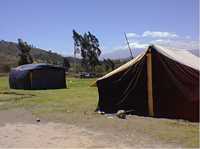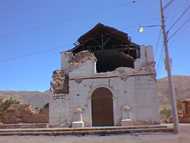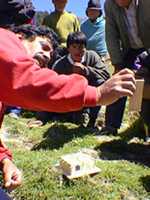|
 The peaceful green hills of Pujili, lying in the shadows of the snowcapped volcano, Cotopaxi, look out on one of the most beautiful views in all of Ecuador. But on February 23, the serene beauty of this land and its inhabitants was shaken by an earthquake measuring 5.6 on the richter scale. Over 4000 people, mostly living in small unstable structures, were left homeless and have been living in tents since. Each tent is inhabited by anywhere from ten to twenty people despite a lack of electricity, drinkable water and adequate protection from the elements. The peaceful green hills of Pujili, lying in the shadows of the snowcapped volcano, Cotopaxi, look out on one of the most beautiful views in all of Ecuador. But on February 23, the serene beauty of this land and its inhabitants was shaken by an earthquake measuring 5.6 on the richter scale. Over 4000 people, mostly living in small unstable structures, were left homeless and have been living in tents since. Each tent is inhabited by anywhere from ten to twenty people despite a lack of electricity, drinkable water and adequate protection from the elements.
 "After the earthquake we were all abandoned, our homes were destroyed and we had no where to go with our families and our animals," said Norma Mayo, an inhabitant of Pujili, "We didn't have much to do but ask god for help." Mayo is the president of a group of twenty families living in a section of Pujili called La Gloria, whose situation is especially grave because the earthquake has triggered a steady sinking of their farmland. To make matters worse, the government, which had originally promised assistance, tore down the tents in Pujili because of a law prohibiting families from living in tents for over sixty days.
"After the earthquake we were all abandoned, our homes were destroyed and we had no where to go with our families and our animals," said Norma Mayo, an inhabitant of Pujili, "We didn't have much to do but ask god for help." Mayo is the president of a group of twenty families living in a section of Pujili called La Gloria, whose situation is especially grave because the earthquake has triggered a steady sinking of their farmland. To make matters worse, the government, which had originally promised assistance, tore down the tents in Pujili because of a law prohibiting families from living in tents for over sixty days.
 
 Luckily for Norma Mayo and the people of La Gloria, the government was not the only organization that took action. The Fundacion de Esquel, along with the Universidad Catolica and the Diario "Hoy", realized the gravity of the situation. Esquel and Hoy were able to raise enough money to purchase a new plot of land for Norma Mayo and the twenty families in La Gloria. In addition, the engineering and architecture departments of the Universidad Catolica pledged to assist the families in the planning and construction of safer houses.
Luckily for Norma Mayo and the people of La Gloria, the government was not the only organization that took action. The Fundacion de Esquel, along with the Universidad Catolica and the Diario "Hoy", realized the gravity of the situation. Esquel and Hoy were able to raise enough money to purchase a new plot of land for Norma Mayo and the twenty families in La Gloria. In addition, the engineering and architecture departments of the Universidad Catolica pledged to assist the families in the planning and construction of safer houses.
 "We are going to help them construct houses that are simple, strong and based on their options and resources," said Eduardo Gortayre, a professor of architecture at Universidad Catolica,
"We are going to help them construct houses that are simple, strong and based on their options and resources," said Eduardo Gortayre, a professor of architecture at Universidad Catolica, "They will learn how to build the houses themselves and will participate in making proper houses for their families. Every part of the construction, the lights, plumbing, doors and windows, are state of the art design, and although simple, will withstand an earthquake better than their old houses." A key component of the project is that the families of La gloria will be doing the majority of construction themselves and will not only learn how to construct houses, but will also be able to teach their neighbors. Five Architecture and engineering students from the Universidad Catolica will live in Pujili until the project is completed to help the inhabitants with construction, architectual design and land management. "They will learn how to build the houses themselves and will participate in making proper houses for their families. Every part of the construction, the lights, plumbing, doors and windows, are state of the art design, and although simple, will withstand an earthquake better than their old houses." A key component of the project is that the families of La gloria will be doing the majority of construction themselves and will not only learn how to construct houses, but will also be able to teach their neighbors. Five Architecture and engineering students from the Universidad Catolica will live in Pujili until the project is completed to help the inhabitants with construction, architectual design and land management.
 In addition to helping one of the neediest sectors of Pujili, Cornelio Marchan, the executive president of Esquel, said that the synthesis of organizations working on the project is an example of civil society's power to come together and solve problems.
In addition to helping one of the neediest sectors of Pujili, Cornelio Marchan, the executive president of Esquel, said that the synthesis of organizations working on the project is an example of civil society's power to come together and solve problems.
 "We may not have a global village yet," said Marchan, "but this project shows we have a local village." Marchan also hopes that the project will highlight the responsibility of the government and put pressure on them to help the rest of the people left homeless by the earthquake.
"We may not have a global village yet," said Marchan, "but this project shows we have a local village." Marchan also hopes that the project will highlight the responsibility of the government and put pressure on them to help the rest of the people left homeless by the earthquake.
 But for Norma Mayo and her neighbors, the future is already looking brighter. In addition to having space for homes and farmland, the plot of land purchased by Esquel and Hoy also includes extra room for the construction of a community centers, playing fields and an artisan workshop where members of the community can earn a living. After all that, there is still some land remaining.
"Maybe we can build a bull ring," suggested one of the proud new landowners.
"Good idea," said Professor Gortayre," and when construction is completed we will all have a party and hold bullfights to celebrate."
But for Norma Mayo and her neighbors, the future is already looking brighter. In addition to having space for homes and farmland, the plot of land purchased by Esquel and Hoy also includes extra room for the construction of a community centers, playing fields and an artisan workshop where members of the community can earn a living. After all that, there is still some land remaining.
"Maybe we can build a bull ring," suggested one of the proud new landowners.
"Good idea," said Professor Gortayre," and when construction is completed we will all have a party and hold bullfights to celebrate."
|
|




